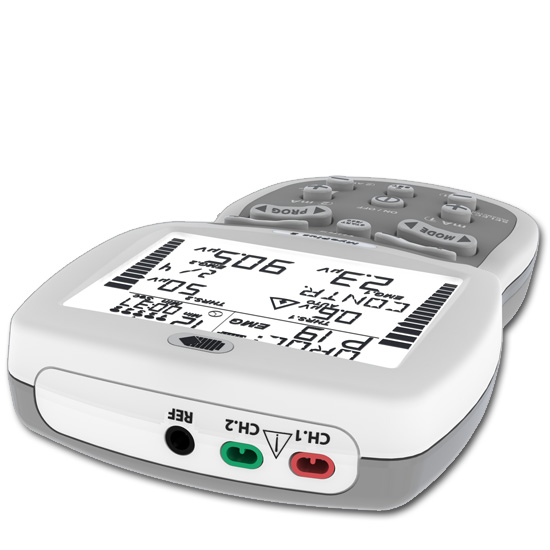NeuroTrac® MyoPlus2

- The Classic Biofeedback / ETS / Stimulation device. A proper tool for training and progress assessment.
- Pre-set programmes for Incontinence treatment, Sports and muscular development, neuro-muscular Rehabilitation.
- Designed for Physiotherapist in mind to be used as a portable tool. Suitable as a personal trainer for in-clinic or home use (under guidance).
- 2 channel EMG (Biofeedback) combined with 2 channels NMES (stimulation).
- 2 channel ETS (EMG triggered stimulation) with stimulation on 2 channels.
- Simple single-phase or multiphase operation: multiphase allows EMG/ETS/STIM to be combined in one programme.
- Multilingual LCD screen and voice prompts for Biofeedback.
- Manual and Automatic threshold control.
- EMG Biofeedback between stimulation (muscle activity and tiredness indication when using muscle stimulation).
- Stand alone device or used in conjunction with established multilingual software.
- Now with Bluetooth connectivity! The unit sends up to 10 metres of wireless data to PC software
- For home users: Produces and prints (with the optional PC Software) the comprehensive patient progress reports on a day to day basis providing average readings (2 channels) on work/rest, peak, onset and muscle release times, work and rest deviations and the average mA current.
- Used as a learning tool for both patient and clinician with emphasis on improving treatment techniques in the use of EMG and Neuromuscular stimulation.
- 4 x AA batteries {No mains required}.
Re-order code: MYO220A. Please note: we don't sell to general public, please obtain from your local distributor.
• What is ETS and how to use it
• What is EMG Biofeedback
• Work / Rest assessment report
Video Tutorials
What is ETS and how to use it
ETS (EMG triggered Stimulation) treatment is especially useful for stroke rehabilitation and Pelvic Muscle improvement. ETS is a combination of voluntary contractions with stimulation. A single ETS session typically lasts 5-15 minutes. The treatment is similar to EMG work/rest with the only one difference: as soon as you reach the target threshold during the Work period, the stimulation occurs which helps to support the contracted muscle.

The ETS session begins from adjusting the mA to the comfortable contraction level. Then it is a repetitive pattern of Work prompts; when the Patient should contract the muscle to reach the target threshold, and Relax prompts; when the Patient has time to relax and get ready for the next trial. The Target threshold measured in Microvolts could be set to Automated regime, when it goes up and down depending on the running muscle performance. The threshold level is always in the middle of the LED bargraph, normally displayed as an arrow - this helps to correlate the ETS target threshold with the visual bargraph.

What is EMG Biofeedback
Electromyography (EMG) or Biofeedback is a technique for evaluating and recording the electrical activity produced by skeletal muscles. EMG is performed using an instrument called an electromyograph, to produce a record called an electromyogram. An electromyograph detects the electrical potential generated by muscle cells when these cells are electrically or neurologically activated. The signals can be analyzed to detect medical abnormalities, activation level, recruitment order or to analyze the biomechanics of human or animal movement.
1. Using the NeuroTrac™ device, find the muscle and place a pair of skin electrodes on the main bulk of the selected muscle, with the separation of 1-5 cm between the electrodes.
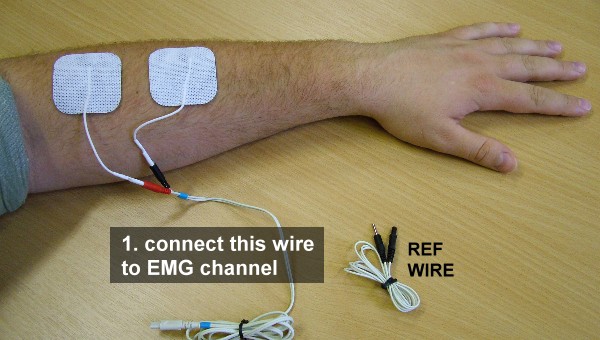
2. Always remember to Use the reference Wire! Place the reference Electrode anywhere on the body, this will provide the accuracy to the measurement.
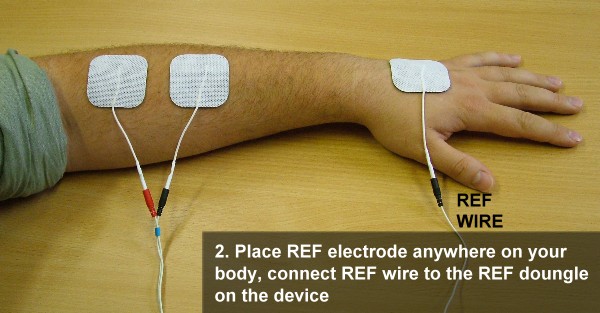
3. After you place the REF and measuring pair of electrodes, connect them to the unit. Your level of relaxation/contraction, measured in microvolts, is displayed. When there is no interference and a proper connection, a reading below 4 microvolts is considered as a relaxed muscle indicator.
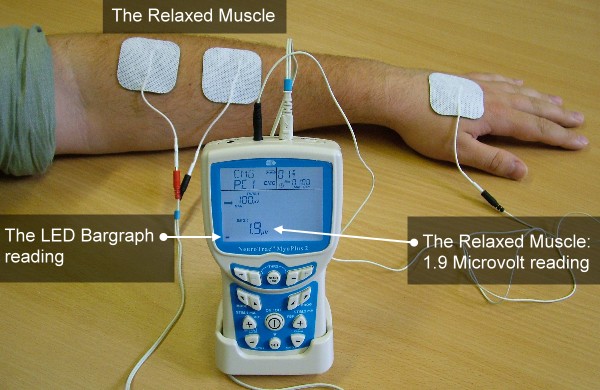
4. When you contract your muscle, you can observe that the bargraph reading goes up with the contraction. If you cannot light the top LEDs on the bargraph, you can re-scale the bargraph to be more sensitive, by decreasing the threshold (THRS button).
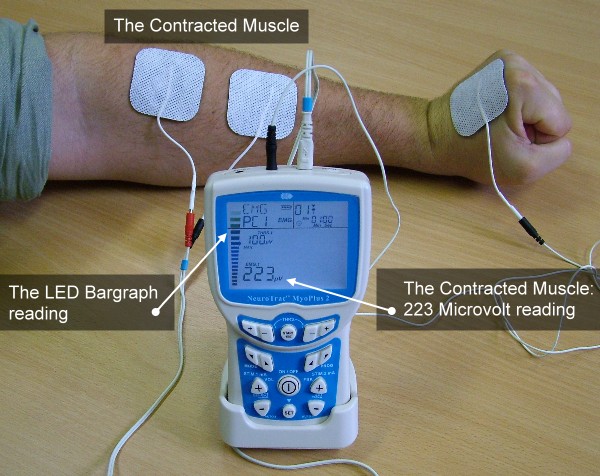
5. You can use the optional PC Software with the MyoPlus4: you will see your EMG biofeedback reading ont he PC as a running graph.

EMG Work/Rest Assessment
The NeuroTrac™ MyoPlus2 allows you to complete the Biofeedback Work / Rest assessment. This is an example of what your own might look like:

When you run the MyoPlus2 programme, the Patient is prompted to contract the muscles as fast as possible and keep them contracted over the threshold level, during the Work segment of time (5 seconds). After the Work segment, there is a Rest segment (5 seconds), where the Patient is prompted to relax the muscle as fast as possible and keep relaxed significantly below the threshold, over the Rest period of time. A good level of relaxation is below 4 uV. An excellent level is below 1 uV (make sure your device does not have too high or unstable a reading due to magnetic interference - read the manual thoroughly to help understand how to reduce magnetic interference as much as possible).
Once the Work / Rest assesment is finished, the statistics are displayed on the LCD display. The comparative analisys of the statistics collelcted from previous assessments gives you the key to understand the progress of muscle rehabilitation. The statistics are explained in the Manual.
Example of Work / Rest assessment (Using the NeuroTrac PC Software):
When your NeuroTrac MyoPlus2 is connected to the optional NeuroTarc Software, The Software generates visual prompts on the screen:
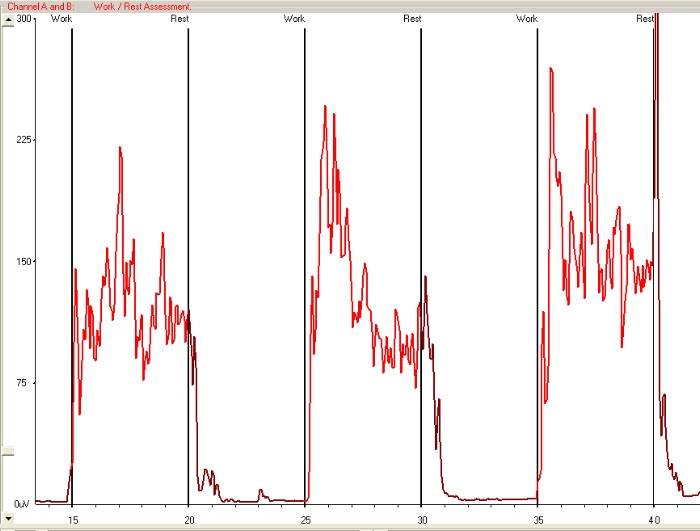
Work / Rest assessment report
The assessment record is stored in the Software. The Report of the Work / Rest assessments could be generated, where you can compare the graphs to be able to identify the progress trends:
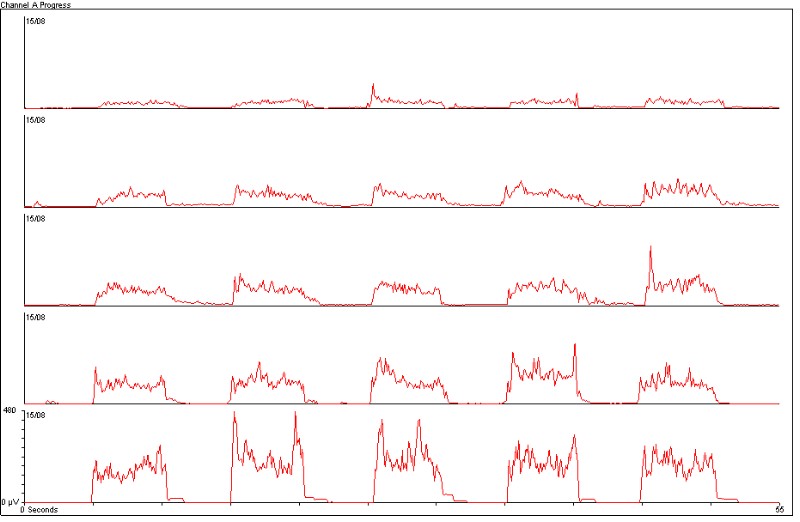
Statistics
When you do one trial (one repetition of Work / Rest), the unit measures the following statistics:
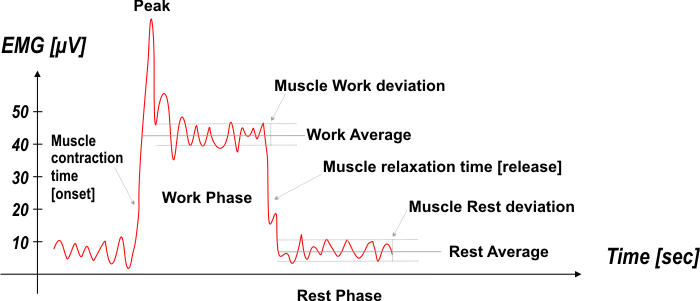
Work Average [µV] - the overall average microvolts achieved during all the work periods of the session. Generally the higher the Work average is, the better the muscle performance.
Rest Average [µV]the overall average microvolts during all rest periods of the session.
Generally the lower the Rest average is, the better the muscle performance. It is very important how low you can relax your muscles in terms of microvolts. Below 4µV a muscle is beginning to rest. If the Rest average is above 4µV make sure you use the EMG reference lead wire! A reading above 4µV commonly means the muscle is overstimulated or tired after a long EMG training session.
Onset Average [sec] - This is the average time taken in seconds to achieve 75% of the work average of all work segments, any values over 2 seconds are ignored.
Generally this parameter measures how fast you can contract a muscle, the shorter the Onset average time is, the better the muscle performance. Readings below 1 second can be considered normal. The time it takes to contract a muscle gives an indication on the recruitment of the fast twitch fibres. If the onset time was slow, the recruitment percentage of the fast twitch fibres would be less than if the onset time was faster.
Release Average [sec] - This is the average time taken in seconds to relax below 37.5% of the work average of all work segments, any values over 2 seconds are ignored. Generally this parameter measures how fast you can relax a muscle, the shorter the Release average time is, the better the muscle performance.
Normally a healthy muscle reverts back to a low resting EMG value in less than one second. If the muscle takes longer to revert back to rest then there will be a reason, such as muscle or nerve damage or some other underlying problem.
| Pelvic Floor: P01-P19 | Sports: P01-P21 |
Rehab: P01-P08 |
CUSTOM |
|
P1 - Pelvic floor pain |
P1 - Warm Up |
P1 - Muscle growth |
EMG Custom x 2 STIM Custom x 2 ETS Custom x 2 P&A Custom x 5 P+A Custom is suitable for a tailor made programme to be set up with Passive STIM and Active EMG / ETS phases, all in one programme. |
| Protocols | Author | Download |
|---|---|---|
| Treatment of the Hemiplegic Shoulder (Stroke) through Biofeedback: Case Study | Verónica Bargueño, Juan Nicolás Cuenca & Eric Lazar | |
| F.E.S. in Stroke | Juan Nicolás Cuenca & Eric Lazar | |
| Urinary Incontinence | Julia Herbert Grad. Dip. Phys. MCSP SRP Specialist Continence Physiotherapist | |
| Stress Urinary Incontinence, using EMG Triggered Stimulation - NEW | Maciej Kisiel, Henryk Konon MD | |
| Pelvic Floor Muscle Activity in Sitting & Standing Postures | R Saphod, C Maher and C Richardson | |
| Fecal Incontinence | Pirkko Raivio Specialist Continence Physiotherapist | |
| Incontinence Case Reports | Pirkko Ravio Specialist Continence Physiotherapist | |
| Patellofemoral Pain | James Selfe. PhD. MA. GD Phys. MCSP. SRP. Lecturer Chartered Physiotherapist. | |
| Prolapse: Pelvic Floor Muscle Training for Women | Karen Radford, MSc, MCSP and Funmi Odofin, BSc, PG Cert. MCSP |
EMG (Biofeedback)
- Dual channel EMG
- EMG Range: 0.2 to 2000 μV RMS (continuous)
- Sensitivity: 0.l μV RMS
- Accuracy: 4% of μV reading +/-0.3 μV at 200 Hz
- Selectable Bandpass filter - 3db Bandwidth,
- a. Wide: 18 Hz +/- 4 Hz to 370 Hz +/- 10% - Reading below 235 microvolts 10 Hz +/-3 Hz to 370 Hz +/- 10% - Reading above 235 microvolts
- b. Narrow: 100 Hz +/- 5% to 370 Hz +/- 10%
- Notch filter: 50 Hz (Canada 60Hz) - 33 dbs (0. 1% accuracy)
- Common Mode Rejection Ratio: 130 dbs Minimum @ 50 Hz
- Work / Rest periods: 2-99 seconds
- Number of Trials: 1-99
STIM (Neuromuscular Stimulation)
- Dual channel Stimulator
- Amplitude: 0-90 mA into 500 Ohm load - actual mA will tend to be less
than indicated due to Electrode impedance: at 1000 Ohms load (Electrodes
in poor condition) the maximum will be limited to 75 mA, at 1500 Ohms
load the maximum will be limited to 50 mA. - Type: Constant current, maximum output
voltage 70 Volts +5 / -10 Volts - Waveform: Symmetrical, rectangular,
bi-phasic with net zero DC current - Pulse width selection: 50-450 μS (2% accuracy)
- Pulse rate selection: 2-100 Hz (2% accuracy)
- Work / Rest periods: 2-99 seconds
- Time 1 - 99 minutes
- Ramp up time: 0.1 - 9.9 seconds
- Preset and user programmable treatment Programs
- Automatic output shut off with detection of open electrode above 0.5 mA
Battery: 4 x AA. Low battery indication at 5.4 volts +/- 0.2 volts, automatic shut off when voltage dropps below the low indication. Replace the batteries immediately! The device goes off automatically when not in use (energy saving): for example when in settings and no key pressed over 1 minute, when in stimulation mode (home screen) and all channels are 0mA.
Expected average battery set life [of standard 800 mAh, alkaline]:
a. MyoPlus2: 12-16 hours in STIM, 25 hours in EMG mode.
b. MyoPlus4: 8-16 hours in STIM, 25 hours in EMG mode.
Environmental Conditions for use: +10 to +30 degrees Centigrade. 0-90% Humidity.
Environmental conditions for storage & transport: -10 to +50 degrees Centigrade. 0-90% Humidity.
Physical dimensions: Length 150 mm, Width 89 mm, Depth 35 mm.
Weight: MyoPlus2 device: 0.16 Kg (without batteries).

 devices
devices









